Disclosure: We may earn commissions if you purchase products after clicking on a link from our site.
Are you interested in hunting red deer? Would you like to learn how to hunt red deer? Red deer, also called the Monarch of the Mountain, is considered the most beautiful antlered animal on the earth.
Hunting red deer is challenging as it is very elusive, lives in thick forested cover, and has a good sense of smell, eyesight, and hearing. In this article, we share and discuss information and strategies to help you improve your chances of a successful red deer hunt.
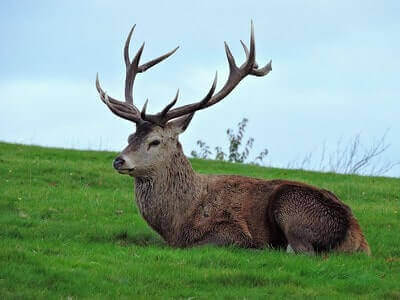
Red Deer History
The red deer, scientifically known as Cervus elaphus, holds a rich history deeply intertwined with human civilization. Originating from Eurasia, these majestic creatures have been revered and hunted by humans for thousands of years.
Historical records and archaeological findings suggest that red deer were depicted in cave paintings by early humans, indicating their significance in ancient cultures. Throughout history, red deer have been valued for their meat, hides, antlers, and as symbols of strength and nobility.
They have also played roles in various mythologies and folklore across different cultures. Over time, red deer populations have faced challenges due to habitat loss, hunting pressure, and changes in land use patterns. Today, red deer are not only iconic symbols of wilderness but also subjects of conservation efforts aimed at ensuring their survival for future generations.
How To Hunt Red Deer
1. Scouting Red Deer
Scouting red deer involves a combination of fieldcraft, knowledge of their habitats, and understanding their behavior. The process typically begins by studying maps and aerial imagery to identify potential locations where red deer are known to inhabit, such as forests, woodlands, and mountainous regions.
Once on-site, scouting involves searching for signs of red deer activity, including tracks, droppings, rubs, and bedding areas. Observing their feeding patterns and movements can also provide valuable insights into their behavior and preferred habitats.
Additionally, scouting often entails using optics like binoculars or spotting scopes to scan the landscape for red deer, especially during dawn and dusk when they are most active. Understanding wind direction and prevailing weather conditions is crucial to avoid alerting deer to your presence. Successful scouting requires patience, keen observation skills, and a deep appreciation for the natural environment that red deer inhabit.
Before you go hunting for red deer, scout the area for signs of deer activities, possible bedding and feeding areas as well as water sources. Look for tracks and if you find some, search for any heavy tracks as there will often be heavy stags with the herds. Also, keep your eyes open for scat.
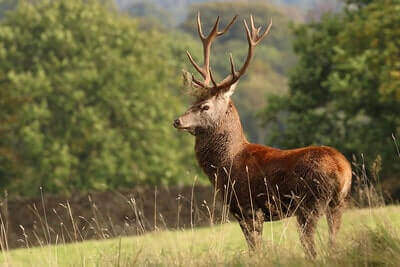
2. Predator Calls
Using predator calls can be an effective strategy when hunting red deer, especially during the rutting season when stags are more responsive to calls. Mimicking the sounds of distressed prey, such as fawns or injured animals, can attract curious red deer, including dominant stags eager to investigate potential threats to their territory.
Common predator calls used for red deer hunting include fox calls or distress calls, as well as the sounds of other predators like coyotes or wolves. Hunters typically position themselves downwind of their intended hunting area and use the calls sparingly to avoid alarming the deer.
However, it’s essential to note that while predator calls can be useful, success ultimately relies on proper timing, technique, and understanding the behavior of red deer in the specific hunting area. We did a review of the best predator calls that you can read from this link.
3. Bait
Using bait when hunting red deer can be a controversial strategy due to regulations in many areas and ethical considerations. However, where legal and ethical, baiting can be effective, especially in areas where natural food sources are scarce or during periods of extreme weather.
Hunters often use bait such as grains, fruits, vegetables, or even commercially available deer attractants to lure red deer into specific areas, typically near hunting blinds or stands. Baiting allows hunters to concentrate on deer activity, increasing the likelihood of a successful hunt.
However, hunters must ensure they comply with local regulations regarding baiting, including restrictions on the type and quantity of bait used, as well as any associated hunting practices. Additionally, baiting should be done responsibly to avoid disrupting natural wildlife behavior or causing harm to the ecosystem.
Bait can be used to hunt red deer but it is not one of the most effective ways. You can use corn, soybeans, or other foods to create a bait pile. They set up some distance from the bait pile, preferably with cover with a line of sight. You can also use salt or mineral licks to attract red deer to your bait pile. Additionally, you can read a review of the best salt licks for deer.
A blind or treestand can be used to wait for the deer. If you are interested in ground blinds and treestands, we reviewed the best hunting ground blinds and the best climbing treestands that you can read from these links.
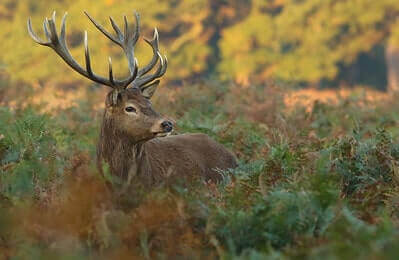
4. Stop & Stalk
The spot and stalk hunting method is a popular and effective strategy employed by hunters when pursuing red deer. This method involves carefully observing the landscape from a vantage point, such as a hill or ridge, to spot deer from a distance.
Once a red deer is spotted, the hunter then plans a stalk, moving quietly and stealthily to get within shooting range. This approach requires patience, stealth, and excellent fieldcraft skills to remain undetected by the keen senses of the red deer.
Hunters need to study the terrain, wind direction, and animal behavior to execute a successful stalk. The spot-and-stalk method offers a thrilling and challenging hunting experience, allowing hunters to immerse themselves in the natural environment while pursuing red deer.
5. Glassing
Glassing is a fundamental technique employed by hunters when pursuing red deer. It involves using binoculars or spotting scopes to scan the landscape for signs of deer activity, such as movement, feeding behavior, or bedded-down individuals.
Hunters often position themselves in elevated areas with a clear line of sight, such as hilltops or ridges, to maximize their field of view. By systematically scanning the terrain, hunters can identify potential targets and plan their approach accordingly.
Glassing allows hunters to cover large areas efficiently and reduces the need for unnecessary movement, minimizing the risk of alerting deer to their presence. This method requires patience, keen observation skills, and a thorough understanding of red deer behavior to effectively locate and pursue these elusive animals.
Look for a high elevation and position yourself there using cover-to-glass for red deer. Use binoculars or a spotting scope to search for red deer. Red deer are often found in thick forested cover, therefore glassing from a high point with quality optics will help you locate the deer. If you are interested in high-quality optics, we reviewed the best hunting binoculars and the best spotting scopes that you can read.
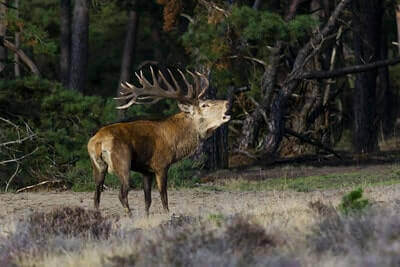
6. Hire An Outfitter
Hiring an outfitter can offer several advantages when hunting red deer. Outfitters often have extensive knowledge of the local terrain, wildlife behavior, and hunting regulations, which can increase the likelihood of a successful hunt.
They typically provide logistical support, including transportation, accommodations, and meals, allowing hunters to focus solely on the hunt without worrying about logistical details. Outfitters may also have access to private hunting areas with higher deer densities, increasing the chances of encountering quality game. Additionally, they often provide experienced guides who can offer valuable insights and assistance during the hunt.
However, there are also potential disadvantages to hiring an outfitter. Cost can be a significant factor, as outfitted hunts can be expensive due to the fees associated with services and access to prime hunting areas. Some hunters may prefer the challenge and satisfaction of planning and executing their hunts independently, finding fulfillment in the self-reliance and adventure of the experience.
Additionally, hunters may have less flexibility and freedom when hunting with an outfitter, as they must adhere to the outfitter’s schedule and rules. Finally, the quality of the outfitter’s services and the hunting experience can vary widely, so it’s essential for hunters to thoroughly research and select reputable outfitters to ensure a positive experience.
An outfitter is a valuable and trusted resource that you can call upon at any time before and during the hunt. They know the hunting laws and can advise you regarding following them. Additionally, they have experience with hunting safety and can help with injuries and animal attacks.
7. Wind Direction
The wind direction plays a crucial role when hunting red deer. Red deer possess a keen sense of smell, allowing them to detect the scent of approaching predators or hunters from a considerable distance.
Therefore, hunters must always pay close attention to the wind direction to prevent their scent from alerting the deer and causing them to flee. Ideally, hunters should position themselves downwind from their quarry, ensuring that their scent is carried away from the deer.
By strategically planning their approach based on the wind direction, hunters can increase their chances of remaining undetected and getting within range for a successful shot. Additionally, hunters should use natural terrain features, such as hills or valleys, to their advantage, using them to block or redirect their scent as they stalk or wait for red deer.
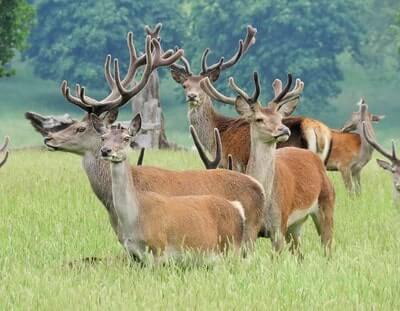
8. Trail Cameras
You can set up trail cameras to collect information on the movements of red deer. From the information gathered, you can learn where there might be bedding areas, travel routes, and food and water sources. You can also learn when they leave their bedding areas to go feed and when they return.
You could identify stags that may be of interest to you from the cameras and try to pattern them. You could also learn about how many of them travel in a herd as well. With this information, you can plan where you want to set up a treestand or hunting blind.
It will also help you determine if stop and stalk is the hunting method you want to use or if still hunting is the best option. We did a review of the best trail cameras on the market today that you can read from this link.
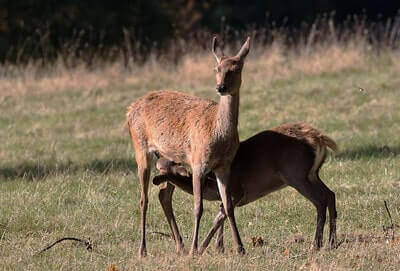
Red Deer Hunting Tips
1. Red deer are most active during the early morning and late afternoon.
2. Red deer have a good sense of smell, eyesight, and hearing.
3. During the roar, the males are more concerned about finding hinds and become less cautious. This presents an opportunity to hunt them.
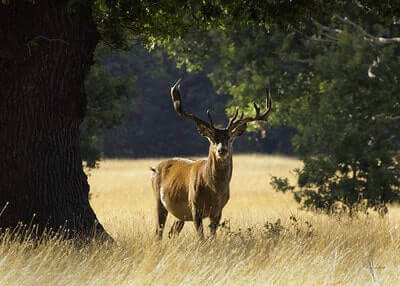
4. Red deer will remain in thick forest cover during the day.
5. Always hunt into the wind so the wind is in your face to avoid your scent reaching the deer.
6. Carry your weapon in your hand as opposed to it being slung over your shoulder when stalking a deer in the bush. You want to minimize movement when you line up a shot.
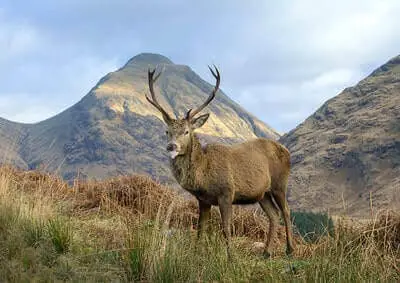
7. Carefully stalk along mid-valley terraces where there is a lot of feed.
8. Use calls to lure red deer out from thick cover. The red deer caller is an effective caller to lure both stags and hinds.
9. When scouting for red deer, look for tracks, droppings, and heavy tracks made by big stags that are always in a herd.
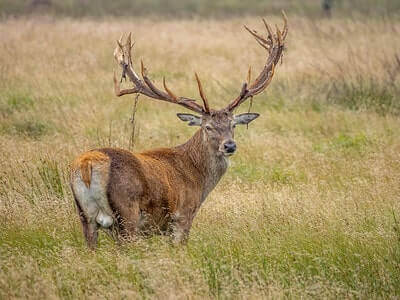
10. When field judging a red deer antler, look for long beams with widespread and many ends.
11. The best time to hunt for red deer is during the rut which runs from mid-September to mid-October.
12. You can hire an outfitter to hunt red deer.
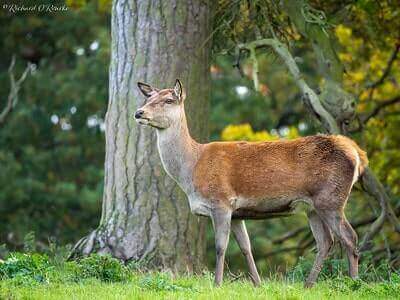
13. The stop-and-stalk hunting method is one of the popular methods to hunt red deer.
14. Red stags are very elusive.
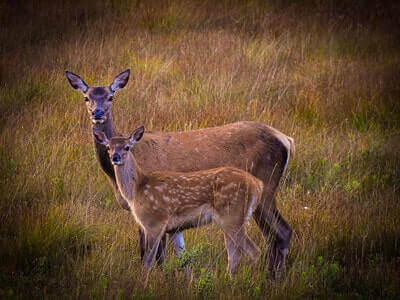
The Bottom Line
The red deer is one of the prized big game animals in Europe and most of the world. They are elusive and have a good sense of smell, eyesight, and hearing. Hunting the red stag is challenging for all of those reasons and more. They are found in a very thick cover which helps keep out predators.
In this article, we shared information and knowledge to help you have a successful red stag hunt. If you are interested in hunting other exotic animals, then how to hunt sika deer is a good read. You can also read how to hunt blacktail deer, how to hunt axis deer, how to hunt fallow deer, and how to hunt red deer.